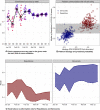Elusive consensus: Polarization in elite communication on the COVID-19 pandemic
- PMID: 32923600
- PMCID: PMC7455486
- DOI: 10.1126/sciadv.abc2717
Elusive consensus: Polarization in elite communication on the COVID-19 pandemic
Abstract
Cues sent by political elites are known to influence public attitudes and behavior. Polarization in elite rhetoric may hinder effective responses to public health crises, when accurate information and rapid behavioral change can save lives. We examine polarization in cues sent to the public by current members of the U.S. House and Senate during the onset of the COVID-19 pandemic, measuring polarization as the ability to correctly classify the partisanship of tweets' authors based solely on the text and the dates they were sent. We find that Democrats discussed the crisis more frequently-emphasizing threats to public health and American workers-while Republicans placed greater emphasis on China and businesses. Polarization in elite discussion of the COVID-19 pandemic peaked in mid-February-weeks after the first confirmed case in the United States-and continued into March. These divergent cues correspond with a partisan divide in the public's early reaction to the crisis.
Copyright © 2020 The Authors, some rights reserved; exclusive licensee American Association for the Advancement of Science. No claim to original U.S. Government Works. Distributed under a Creative Commons Attribution NonCommercial License 4.0 (CC BY-NC).
Figures


References
-
- Berinsky A. J., Assuming the costs of war: Events, elites, and american public support for military conflict. J. Polit. 69, 975–997 (2007).
-
- G. Lenz, Follow the Leader? How Voters Respond to Politicians’ Policies and Performance (University of Chicago Press, 2012).
-
- “S.J. Res. 22: Expressing the sense of the Senate and House of Representatives regarding the terrorist attacks launched against the United States on September 11, 2001” (SJ. Res. 22, United States Congress Senate, 2001); www.hsdl.org/?abstract&did=9050.
-
- Iyengar S., Sood G., Lelkes Y., Affect, not ideology: A social identity perspective on polarization. Public Opin. Q. 76, 405–431 (2012).
-
- Webster S. W., Abramowitz A. I., The ideological foundations of affective polarization in the U.S. electorate. Am. Politics Res. 45, 621–647 (2017).
Publication types
MeSH terms
Grants and funding
LinkOut - more resources
Full Text Sources

